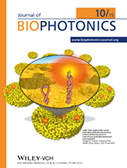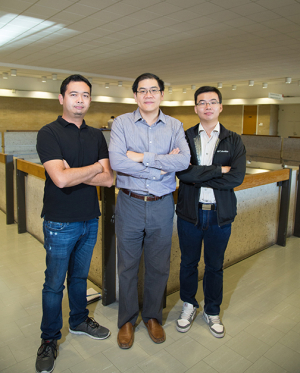The October cover of the Journal of Biophotonics featured molecular sensing research conducted by Wei-Chuan Shih, associate professor of electrical and computer engineering at the UH Cullen College of Engineering.
The study describes the development and testing of a novel sensor based on surface-enhanced fluorescence (SEF). The sensor provides a more economical and convenient means for detection of sequence-specific DNA biomarkers, challenging the current gold standard, polymerase chain reaction (PCR), which is labor-intensive, time-consuming and costly. Specifically, Shih’s SEF sensor possesses recognition elements that can signal the detection of a breast cancer DNA biomarker with sensitivity in the attomole range.
Unlike PCR, the SEF sensor does not require time-consuming duplication of trace amounts of the DNA biomarker. Instead, light-excited localized surface plasmon resonance (LSPR) on the surface of a special gold nanostructure provides the needed signal amplification. The gold nanostructures, known as nanoporous gold disks (NPGDs), were first prepared by Shih’s group in 2012. Their findings on NPGDs were featured on the cover of Nanoscale in 2013.
The NPGD features a tunable diameter between 100 and 1000 nanometers, a thickness from 50 to 100 nanometers, and a three-dimensionally distributed porous network with 10-nanometer pores. The disk drastically enhances the electrical field, and consequently, the ability to amplify optical signals near the surface. The hierarchical nanostructural architecture is unique among all plasmonic nanoparticles.
In 2014, Shih published a paper that described the use of NPGD for breast cancer DNA biomarker detection via surface-enhanced Raman spectroscopy (SERS), another highly sensitive technique for molecular sensing. They demonstrated the detection of single, individual DNA biomarkers when the sensor recognized them.
Shih’s sensors enable sensitive and rapid DNA sequence detection down to the single-molecule level without the need for PCR and its associated sample preparation. The sensors can potentially enable faster and more affordable DNA biomarker detection at resource-limited settings and point-of-care facilities.
“Bypassing PCR, which is the process of reproducing large amounts of targeted molecules for analysis, our sensors can operate at an extremely low count of DNA copies – from one to a few hundred,” Shih said.
Commercialization of these sensors could benefit clinics around the globe where women are examined for breast cancer, especially in poor countries where costly PCR is not an option and shipping DNA samples cross-country is unrealistic.
“You have to be able to conduct a highly sensitive test right there without sophisticated instrumentation and skilled laboratory personnel,” Shih said. “Optical instruments are much less demanding in terms of environment – they’re less expensive and more portable.”

